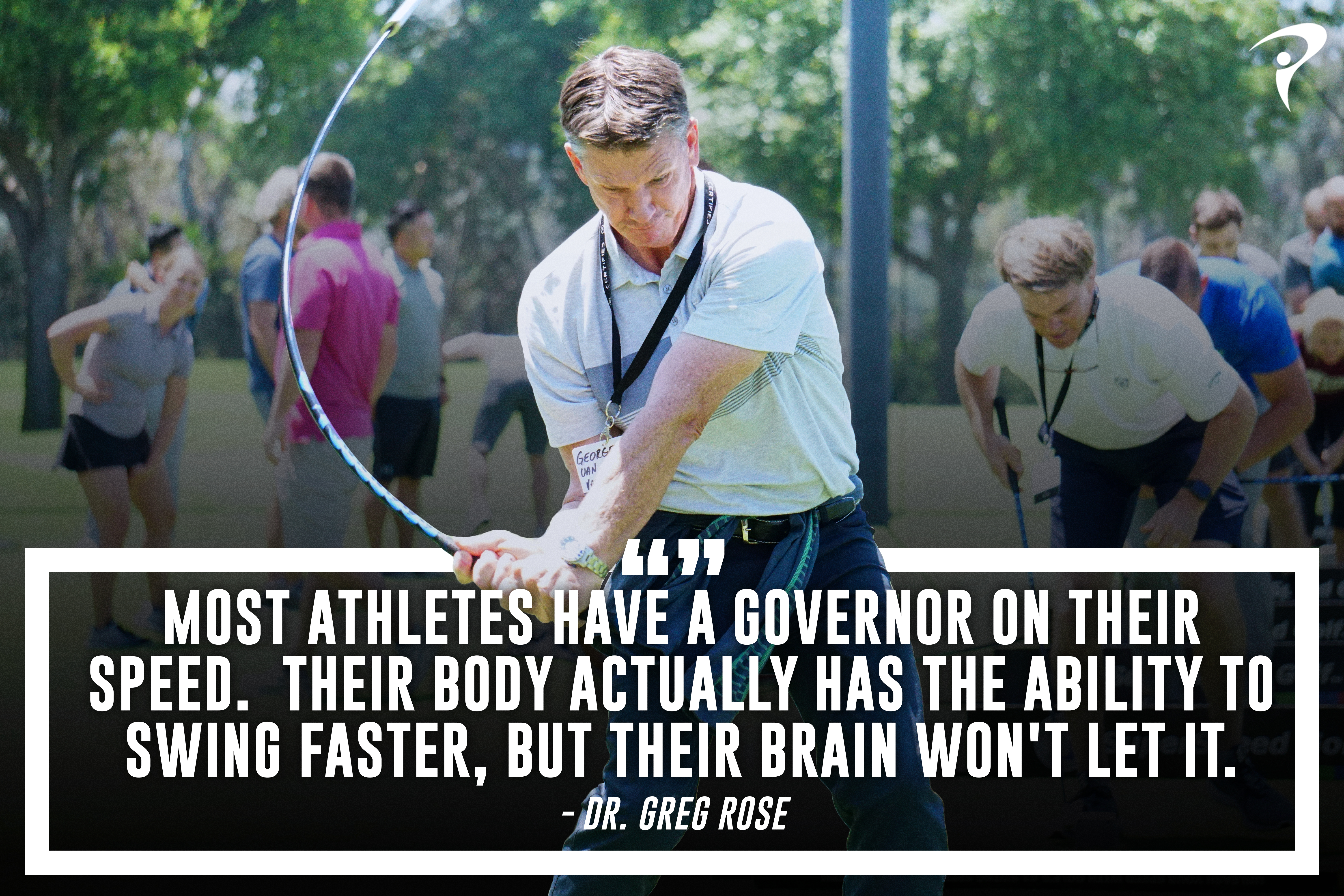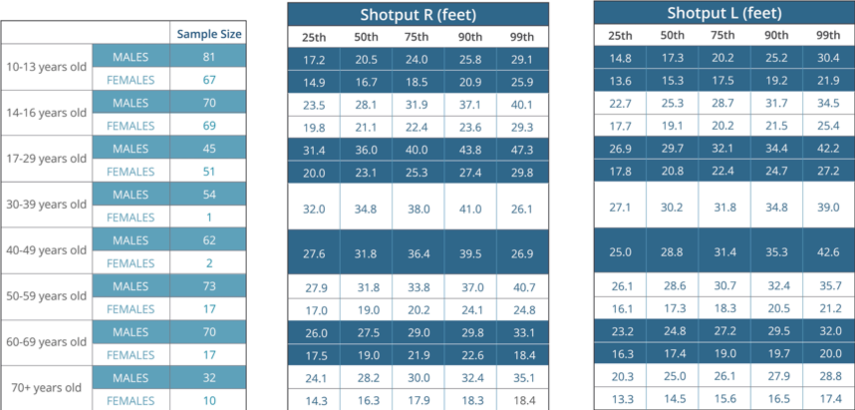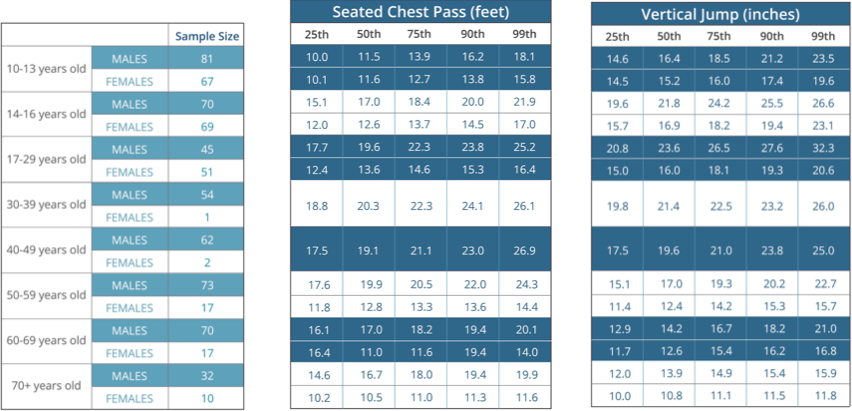IMPROVE MY GAME
Articles
The Safe Way to Train Fast: Determining Your Readiness For Overspeed Training

Overspeed training is one of the hottest things in golf today. Some people call it a training aid, others call it power training and yet others say it will get your stronger and improve your balance. So which one is it and how is it supposed to be used?
Overspeed training in the context of golf is a sport/movement specific nervous system hack to get an athlete to swing the golf club faster. Without getting into the nitty gritty of how it works, overspeed training “tricks” your brain to unlock its restriction (aka “a governor”) on your ability to go as fast as you can.
When you swing an implement faster than you normally do, you can unlock the suppressed speed you already have inside of you and immediately start swinging faster. In some cases it is as much as 5 mph or more in less than 10 minutes. It is pretty amazing!
In the quick fix, quick results driven world of golf today, it is not a mystery why its popularity has skyrocketed. 15 yards in 10 minutes...who wouldn’t want a piece of that? Unfortunately, the misunderstanding of what overspeed training is, has led to dangerous confusion about how and when it should be used, as well as who it is safe for.
What Overspeed Training is Not
Overspeed training is not power training
One confusing part is that overspeed training does make your golf club go faster (in most, not all cases...we’ll get to that in a minute), and speed is an integral part of the power equation. This is what leads to a lot of the confusion around what overspeed training does for the golfer. If your club speed is 100 mph before overspeed training and it is 105 mph immediately following, you have improved your ability to increase speed in that specific motion. You have not improved your ability to produce more power as an athlete. Let me explain...
By completing overspeed training, while you may swing the club faster, you will not improve your ability to jump, squat, deadlift or sprint faster. It is a very isolated and specific way to increase speed in a swinging motion.
A common argument that you might see is when you use overspeed training on a force plate. It is not uncommon to see an increase in the player’s ground force and power output. So overspeed made them more powerful, right?
While this is true in the specific context of the swing, the ability to produce that power was already there in the athlete. It was not created by the overspeed training. The overspeed training just helped give the player the understanding and ability to access the power they already had available to them.
This is why overspeed training isn't a fix-all for every golfer. A golfer has to already possess the ability to generate more power than they are currently doing in the specific context of the golf swing for overspeed training to work.
On the other hand, if you train to improve your power output via moving heavy loads fast, not only can you improve your performance in those lifts and overall speed, but also improve your swing speed. This is because you are training to increase the maximum amount of power available to use in all motions.
It is not a two way street. Improving your swing speed does not mean you improved your power, but improving your ability to produce power will lead to the ability to produce faster swing speeds. Unfortunately, the detail often left out is that if you increase your speed without also increasing your strength and power, you are likely increasing your risk of injury.
Overspeed training is not strength training
On the same note as the power section, overspeed training improves speed through maximizing nervous system efficiency. In order to develop strength, you need to provide enough stimulus (aka lift heavy enough weight) for the system to generate a physiological response beyond what it is already capable. A stick that is barely 2 lbs is nowhere near enough load to generate a strength stimulus, not even for a junior golfer.
If you are a golfer and want to improve your strength, unfortunately there is no quick fix. You have to squat, hinge, push, pull and rotate with enough load a few times per week for months. If you do it though, you won’t be disappointed with the results. In fact, doing it, will increase your potential gains from overspeed training and decrease your risk of injury!
Overspeed training is not a stand alone solution
Before we dive into figuring out if overspeed training is a safe option for you or your client, I need to emphasize that overspeed training is not a stand alone solution. If you are not engaging in a structured golf performance plan that targets mobility, strength and power development and consistently retests and adjusts for you, overspeed training should be avoided.
If you are a fitness, medical or golf professional and only prescribing overspeed training as a stand alone solution to gaining speed, you need to be acutely aware that you are likely placing your client at direct risk for injury. Please take the 15 minutes to evaluate and categorize them before recommending overspeed training.
Overspeed training is one of the greatest assets in a golfer’s arsenal when used at the right time, but inappropriate application of the protocols can cause it to get a bad rap . It’s turning into the deadlift and bench press of the speed world simply because it is being used incorrectly.
Read below to avoid being injured while also maximizing your gains while using overspeed training. It will take two minutes and could significantly reduce your (or your golfers') risk of potential injury.
Which Category are You?
To figure out which category you are, perform the power tests outlined in my earlier article and see what percentile you fall into.
Below are the charts for the power tests and their percentiles for each age group.
* NOTE: Because the sample size for women ages 30- 39 and 40 - 49 are so small, the corresponding values are only reported for men.


Since power is a combination of strength and speed, it's important to know your primary need. Here's Dr. Greg Rose describing the TPI Power Tests and how to determine when to train for strength and when to train for speed. This is a process that is taught at TPI's advanced Power seminars.
Compare your swing speed percentile and power percentile (and also check to make sure you have adequate mobility via the TPI screen). Once you have that information, you’ll be able to place yourself into one of three cateogies below.
Ticking Time Bomb
Overspeed training is not for you! You are in this category if your swing speed percentile is higher than your power percentile and/or if you didn’t pass the rotary tests.
You are already swinging faster than your body is capable of controlling. You are likely achieving this because you are optimizing your technical delivery and/or your equipment to move the club faster. You are in the 95% of golfers who I have talked to who have gotten hurt using overspeed training. If you use overspeed training and do not get hurt, your gains will likely be minimal because you are already swinging as fast as you can.
If this is you, you MUST get involved with a golf performance program focused on improving not only your mobility, but also your strength and power to help you control how fast you are swinging. The benefits of becoming involved with a golf performance program will be that you become more consistent, have less aches and pains and start moving towards the “balanced golfer”category. Continue with the program long enough and you will be ready for overspeed training to safely take you to the next level.
Balanced Golfer
Your percentiles from your power tests and your club speed are within 10% of each other and your mobility looks great. You rotate well and swing on level with how much power you can produce.
If this is you, you are a golfer who should be engaged in a golf performance plan and test every 12 weeks to see how things are changing. There will be points where your speed percentile is below your power percentiles and when that happens, overspeed training is your holy grail! You will pick up speed safely and quickly.
There will also be times where you start to trend towards a “ticking time bomb.” When this happens, you should not be doing overspeed training, but instead focusing on bringing your power and strength numbers up. Progress is a bit of a seesaw based on how you progress, but if you are reassessing a few times per year you can easily manage the changes. Rebalancing of your golf performance program throughout the year is critical to your longevity and performance.
More RPM’s Under the Hood
Your swing speed percentile is below your power percentiles. You are not swinging it as fast as you should be based on your athletic ability to produce power. You also have full mobility in all your rotary centers. If this is you, celebrate! Overspeed training is likely your holy grail for speed immediately.
The one caution for you, like with the balanced golfer, is to continue to retest and assess as your speed increases. You want to be sure you don’t ever fall into the “ticking time bomb” category and are adjusting your program as necessary for optimal results.
The critical element to realize is that while you may be perfect for overspeed training now, you will likely need to refocus your program throughout the year. Bouncing back and forth from from strength and power development to speed building as you develop and/or age and your body changes. I should note these are not exclusive focuses, just areas of emphasis.
The percentiles you are today, could very likely be different in three months. We often see golfers change categories one to two times per year. When that happens, your training focus needs to adjust with you.
One final note if this is you. There is a point where your strong will be strong enough and the rate of return on continuing to build strength will diminish. This is when you would want to explore more advanced programming such as velocity based programming. Nobody knows for sure where this point is yet, but it is likely closer than you think!
Should you do overspeed training year round?
No studies that I was able to find discussed longitudinal improvements and/or causation of those improvements. This is the hardest type of research to do which speaks to the lack of evidence. In house at Par4Successs, we have preliminary findings but not nearly large enough to draw broad based conclusions.
In that light, approaching overspeed training like any other nervous system training is the best approach. There will be times of year (and based on your current category) where overspeed training could be what you need to keep your speeds up or even gain. There will be others, like in the middle of the season when you are already swinging hundreds or thousands of times per week, that overspeed training is likely just increasing your chance of overuse injury and not giving your nervous system a chance to recover.
Does overspeed training outperform strength and conditioning?
There appears to be a bigger jump in club speed when overspeed training is added compared to solely strength and conditioning, by almost three fold. At Par4Success, we completed 6 and 8 week randomized studies and found an average speed gain around 3mph which is three times the average gain for adult golfers in controlled 12 week period with only traditional strength and conditioning.
Looking at our database retrospectively, we found the golfers who add big speed (ie. 10 mph to their club speed in 12 weeks) seem to be in the “more RPMs under the hood” category. Golfers in the “ticking time bomb” category and “balanced golfer” category are the ones who fail to improve their speed much with or without the overspeed training. Interestingly, however, the “ticking time bombs” and “balanced golfers’ tend to be the ones who drastically improve their mobility and or strength and eventually can become the 10 mph gainer down the road.
How much volume is too much?
Most of the studies that I was able to find specifically on increasing swing speed looked at about 100 swings 3x/week (baseball). In practice, common overspeed protocols in golf recommend the same frequency (3x/wk) but increase the volume over the course of the year for a total swings in a year of just under 12,000 additional swings on top of regular playing and practice per year.
Adding thousands of maximal swings per year is concerning for increased risk of injury. Especially for golfers who do not engage in a strength and conditioning program, this is a significant amount of volume without anything to balance against the speed training to keep them healthy.
With this concern in mind, in 2018-19, two studies found no significant difference in swing speed gains between a high volume protocol and a low volume protocol. The low volume protocol required 30 swings (66% fewer than the high volume protocol) with a 2 minute rest between every 10 swings (to allow full glycolytic recovery) and was performed 2x/week.
Based on these two studies and continued positive results with low volume protocols with close to 100 other golfers, it would be my recommendation to avoid high volume protocols that place unnecessary volume on golfers.
In the end, I think Szymanski et al hit it on the head with their highlight of the clear relationship between the fastest bat speeds occurred with the stronger and more powerful players. Golfers should focus on developing strength and power with traditional strength and conditioning techniques to maximize performance, longevity and reduce injury likelihood. From there, overspeed training can become an amazing tool at the right time of the year with lower volume and system loads than are currently being used industry wide.
In conclusion, overspeed training works the exact same with high volume and low volume protocols. For this reason, if you are in the “more RPM under the hood” category you should be utilizing a low volume protocol. If you are a “ticking time bomb” you should not use overspeed training at all. If you are in the “balanced golfer” category, consult with your performance professional as to if overspeed training is right for you.
No matter what category you are in, do not use overspeed as a stand alone solution. It does not increase your power or strength, it increases your speed. Using a comprehensive golf performance plan will guarantee you the most longevity in the game of golf. Find yourself a professional and be sure to reassess your body as it changes a few times per year. You’ll be glad you did!

Chris Finn is a Licensed Physical Therapist, Certified Strength and Conditioning Specialist, Titleist Performance Institute Certified Medical Professional, Certified Precision Nutrition Coach, and trained to perform Trigger Point Dry Needling in North Carolina. Since starting Par4Success in 2012, Chris has and continues to work with Touring Professionals, elite level juniors & amateurs as well as weekend warriors. He has contributed to numerous media outlets including GolfWRX, is a published author, works with many of the nation’s leading coaches and instructors to improve their players and presents all over the country on topics such as Golf Performance, Junior Golf Athletic Development, Injury Prevention and Power/Speed improvement for golfers.
References
- Behrens, M. J., M.S., & Simonson, Shawn R,EdD., C.S.C.S. (2011). A comparison of the various methods used to enhance sprint speed. Strength and Conditioning Journal, 33(2), 64-71.
- Dintiman GB and Ward RD. Sports Speed (3rd ed). Champaign, IL: Human Kinetics, 2003. pp. 3, 16, 69, 73, 97, 98, 142, 184, 189.
- Ebben WP, Davies JA, and Clewien RW. Effect of the degree of hill slope on acute downhill running velocity and acceleration. J Strength Cond Res 22: 898-902, 2008.
- Plisk SS. Speed, agility, and speed endurance development. In: Essentials of Strength Training and Conditioning (2nd ed). Baechle TR and Earle RW, eds. Champaign, IL: Human Kinetics, 2000. pp. 472-482.
- Marsh, J. A., Wagshol, M. I., Boddy, K. J., Michael, E. O., Briend, S. J., Lindley, K. E., & Caravan, A. (2018). Effects of a six-week weighted-implement throwing program on baseball pitching velocity, kinematics, arm stress, and arm range of motion. PeerJ, doi:http://dx.doi.org/10.7717/peerj.6003
- McCrary, J. M., Ackermann, B. J., & Halaki, M. (2015). A systematic review of the effects of upper body warm-up on performance and injury. British Journal of Sports Medicine, 49(14), 935.
- Southard D, Groomer L. Warm-up with baseball bats of varying moments of inertia: effect on bat velocity and swing pattern. Res Q Exerc Sport 2003; 74: 270-6.
- Otsuji T, Abe M, Kinoshita H. After-effects of using a weighted bat on subsequent swing velocity and batters' perceptions of swing velocity and heaviness. Percept Mot Skills 2002; 94: 119-26.
- Montoya BS, Brown LE, Coburn JW, et al. Effect of warm-up with different weighted bats on normal baseball bat velocity. J Strength Cond Res 2009; 23: 1566-9.
- DeRenne C, Ho KW, Hetzler RK, et al. Effects of warm up with various weighted implements on baseball bat swing velocity. J Strength Cond Res 1992; 6: 214-18.
- Ortega-Becerra, M., Sigüenza-Iglesias, J. A., & Asián-Clemente, J. A. (2019). Effects of 4-week training with balls of different weights on throwing velocity in handball players. Journal of Physical Education and Sport, 19, 344-349.
- Wickington, K. L., & Linthorne, N. P. (2017). Effect of ball weight on speed, accuracy, and mechanics in cricket fast bowling. Sports, 5(1), 18.
- Petersen, C.J.; Wilson, B.D.; Hopkins, W.C. Effects of modified-implement training on fast bowling in cricket. J. Sports Sci. 2004, 22, 1035–1039. [CrossRef] [PubMed]
- Szymanski, D. J., DeRenne, C., & Spaniol, F. J. (2009). CONTRIBUTING FACTORS FOR INCREASED BAT SWING VELOCITY. Journal of Strength and Conditioning Research, 23(4), 1338-52.